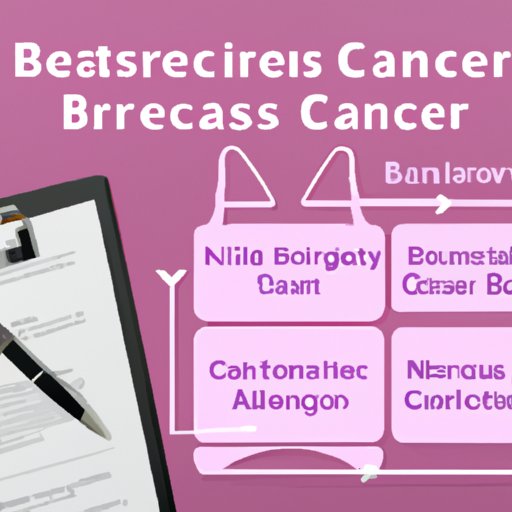Introduction
Breast cancer is one of the most common forms of cancer in women worldwide. Ductal carcinoma in situ (DCIS) is a non-invasive form of breast cancer that can be found through mammograms. While it is non-life-threatening, some women choose to undergo a mastectomy, or the surgical removal of one or both breasts, as a treatment option. In this article, we will explore the pros, cons, and impacts of choosing mastectomy for DCIS treatment.
Understanding DCIS: An In-Depth Look at Mastectomy as a Treatment Option
DCIS is a type of early-stage breast cancer where abnormal cells are found in the lining of the milk ducts in the breast. It is called in situ, which means that it has not spread beyond the milk ducts into the surrounding breast tissue. While it is not life-threatening, it can sometimes lead to invasive breast cancer if left untreated.
Treatment options for DCIS include surgery, radiation therapy, and medications. Mastectomy, the surgical removal of one or both breasts, is a common treatment option for DCIS. During a mastectomy procedure, the entire breast is removed, including the nipple and areola.
Making the Choice: How to Decide if Mastectomy is Right for You in Managing DCIS
When considering whether to undergo a mastectomy for DCIS treatment, several factors must be considered. These include the size of the affected area, the location of the abnormal cells within the breast, and the patient’s overall health and medical history. Age and life expectancy can also play a role in the decision-making process.
Mastectomy has both pros and cons as a treatment option for DCIS. One of the main advantages is that it can provide peace of mind for women who are at high risk for developing breast cancer. Mastectomy can greatly reduce the chance of developing invasive breast cancer in the future. However, it is also an invasive surgical procedure that requires a longer recovery time than some other treatment options.
It is essential to make an informed decision when deciding which treatment option is right for you. Consulting with medical professionals can help you understand the risks and benefits of each option and guide you in making an informed decision.
Beyond the Physical: The Emotional and Psychological Impacts of Mastectomy for DCIS
Mastectomy can also have a significant emotional and psychological impact on women. Losing one or both breasts can affect body image and self-esteem. Coping mechanisms, such as counseling and support groups, can be helpful for patients going through mastectomy.
It is essential to understand that the psychological impact of mastectomy can vary from patient to patient. Some women find the surgery empowering and a way to take control of their health, while others may struggle with the loss of their breasts. It is important to talk to a healthcare professional about how to manage the psychological impact of mastectomy.
Survivor Stories: Personal Accounts on Choosing Mastectomy for DCIS Treatment
Personal accounts from women who have undergone mastectomy can provide insight into the experience of choosing this treatment option. Some women who underwent the procedure reported feeling empowered by the decision, while others described feelings of sadness and anxiety.
For many women, the support of loved ones and healthcare professionals during the process can make all the difference. Support groups and counseling can be helpful in coping with the physical and emotional changes that follow mastectomy.
Alternative Options vs. Mastectomy: Weighing the Pros and Cons for DCIS Patients
Other treatment options for DCIS include radiation, lumpectomy (removal of the affected tissue and not the entire breast), and medications such as hormonal therapy. These alternatives may be preferable for some women, while others may choose mastectomy due to the high risk of developing invasive breast cancer or for personal reasons.
It is essential to weigh the pros and cons of each option carefully. While mastectomy can be effective, it is also a more invasive surgical procedure than other treatment options and can have a more significant psychological impact.
The Fine Print: Navigating Through the Risks and Benefits of Mastectomy for DCIS
Like any surgical procedure, there are risks and benefits to mastectomy. The main risks of mastectomy include bleeding, infection, and complications from anesthesia. Other potential complications include lymphedema, which is swelling in the arm, and numbness or tingling in the chest or arm.
Post-surgical care is an essential component of the recovery process. Patients may need to wear compression garments, take medications to manage pain, and engage in physical therapy to regain mobility. It is essential to speak with a healthcare professional to understand the potential risks and factors to consider when deciding on mastectomy as a treatment option for DCIS.
Conclusion
Choosing mastectomy as a treatment for DCIS can be a daunting decision. It is essential to understand the pros and cons of each treatment option and to make an informed decision with the guidance of a healthcare professional. While the procedure can have physical and emotional impacts, support from loved ones, and counseling can aid in the recovery process. Ultimately, the patient’s overall health and risk of developing invasive breast cancer should be the primary considerations in deciding whether mastectomy is the right treatment option for DCIS.
